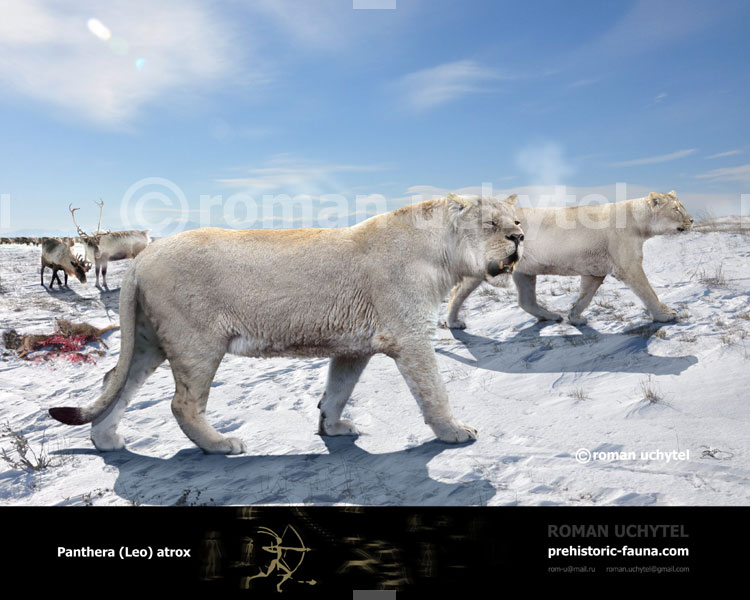Post by dinosauria101 on Sept 1, 2019 14:41:38 GMT 5
American Lion (coalition of 3) - Panthera leo atrox
The American lion (Panthera leo atrox or P. atrox) — also known as the North American lion, Naegele’s giant jaguar or American cave lion — is an extinct lion of the family Felidae, endemic to North America during the Pleistocene epoch (0.34 mya to 11,000 years ago), existing for approximately 0.33 million years. It has been shown by genetic analysis to be a sister lineage to the Eurasian cave lion (Panthera leo spelaea or P. spelaea). The American lion is an extinct animal which originated in North America and went on to colonize part of South America as part of the Great American Interchange. The head-body length of the American lion is estimated to have been 1.6–2.5 m (5 ft 3 in–8 ft 2 in) and it would have stood 1.2 metres (4 ft) at the shoulder. Thus it was smaller than its contemporary competitor for prey, the giant short-faced bear, which was the largest carnivoran of North America at the time. The American lion was not as heavily built as the saber-toothed cat Smilodon populator, which may have weighed up to 360–470 kilograms (790–1,000 lb). Sorkin (2008) estimated it to weigh roughly 420 kilograms (930 lb), but new estimations show a top weight of 351 kg (774lbs.) for the largest specimen and an average weight for males of 255.65 kg (563lbs.).

Arctodus simus
Arctodus (Greek, "bear tooth") — known as the short-faced bear or bulldog bear — is an extinct genus of bear endemic to North America during the Pleistocene ~3.0 Ma.—11,000 years ago, existing for approximately three million years. Arctodus simus may have once been Earth's largest mammalian, terrestrial carnivore. It was the most common of early North American bears, being most abundant in California. It was native to prehistoric North America from about 800,000 years ago, and became extinct about 12,500 years ago. It has been found from as far north as Ikpikpuk River, Alaska to Lowndes County, Mississippi. It is one of the largest bears in the fossil record and was among the largest mammalian land predators of all time. The type specimen came from Potter Creek Cave in Shasta County, California. It would have weighed up to 700-800 kg.
-738x591.jpg)
Credit to Wikipedia
The American lion (Panthera leo atrox or P. atrox) — also known as the North American lion, Naegele’s giant jaguar or American cave lion — is an extinct lion of the family Felidae, endemic to North America during the Pleistocene epoch (0.34 mya to 11,000 years ago), existing for approximately 0.33 million years. It has been shown by genetic analysis to be a sister lineage to the Eurasian cave lion (Panthera leo spelaea or P. spelaea). The American lion is an extinct animal which originated in North America and went on to colonize part of South America as part of the Great American Interchange. The head-body length of the American lion is estimated to have been 1.6–2.5 m (5 ft 3 in–8 ft 2 in) and it would have stood 1.2 metres (4 ft) at the shoulder. Thus it was smaller than its contemporary competitor for prey, the giant short-faced bear, which was the largest carnivoran of North America at the time. The American lion was not as heavily built as the saber-toothed cat Smilodon populator, which may have weighed up to 360–470 kilograms (790–1,000 lb). Sorkin (2008) estimated it to weigh roughly 420 kilograms (930 lb), but new estimations show a top weight of 351 kg (774lbs.) for the largest specimen and an average weight for males of 255.65 kg (563lbs.).

Arctodus simus
Arctodus (Greek, "bear tooth") — known as the short-faced bear or bulldog bear — is an extinct genus of bear endemic to North America during the Pleistocene ~3.0 Ma.—11,000 years ago, existing for approximately three million years. Arctodus simus may have once been Earth's largest mammalian, terrestrial carnivore. It was the most common of early North American bears, being most abundant in California. It was native to prehistoric North America from about 800,000 years ago, and became extinct about 12,500 years ago. It has been found from as far north as Ikpikpuk River, Alaska to Lowndes County, Mississippi. It is one of the largest bears in the fossil record and was among the largest mammalian land predators of all time. The type specimen came from Potter Creek Cave in Shasta County, California. It would have weighed up to 700-800 kg.
-738x591.jpg)
Credit to Wikipedia


